Where Do I Go from Here?
Some thoughts on your first antenna for HF
By Bob Raynor, N4JTE
Okay so you got your ticket and passed the exam as your entry into the world of amateur radio, soooooo are you bored yet? Hope not, because we are finally seeing some sunspots which allow your new voice privileges to be explored on 10 meters as opposed to the two meter stuff that might not be quite what you were hoping for. BUT if you have ventured into the next step and got your General ticket, I would like to give you a basic guideline on your HF antenna possibilities and perhaps answer a few questions along the way.
Your expectations:
I have been doing the ham thing for a lot of years and my addiction to the hobby may not become the same for you, but I think it’s safe to say we all want to be heard well enough to have a qso or at least get a fake 5-9 from a DX contester after yelling back at them in a relatively short time. That said, once on the air for awhile you will make friends and even be able to recognize their voices before hearing their callsigns! This is what keeps old farts like me and others coming back to radio at ridiculous hours, like saying hello to my friend in England G0EVY at 1am or checking in with the HHH net at 4am local to say hello to friends inAustralia andNew Zealand. The excitement of being able to this with some homebrew wire in the trees NEVER gets boring!
It has gotten to the point where I don’t even have to explain these bizarre hours to my xyl, got her trained, so to speak, as long as the garbage is taken out, mortgage paid, the wood chopped for the fireplace and the driveway shoveled so she can get to work; while I put up a wire beam for 80 meters halfway into my neighbors yard, all is fine in my ham world. Yeah right!
Anyway, point of this short article is to try to focus our newly licensed Ham brethren and give you folks some tried and true antenna advice before you get sucked into buying a commercial antenna you can build yourself or more importantly avoid wasting hours and money on some magic internet antenna.
Timing is Everything:
As a newly licensed ham, you have joined us after a pretty long dry spell, propagation wise. Band conditions on the upper bands like 10, 15 and 20 meters are showing some incredible signs of life. What this means is you don’t need a $5000 tower and beam to speak to another ham half way around the world, propagation will do most of the work with the antennas I am going to describe and these conditions should last a few years, and this stuff will cost you less than you might spend for a month of internet service!
What’s your Preference?
So many frequencies and only so much time to play on the radio! Good time to make some choices, are you ultimately trying to see how far away you can be heard, or maybe you’ve got another new ham friend some miles away you want to keep in touch with? Or even maybe you are more technically inclined and want to explore antenna building or perhaps contesting? Time for you to focus a little bit, after a little while on SSB you’ll find a niche of interest, BUT; your antenna is your key element to getting it done. A $2000 radio will become an expensive doorstop without studying, reading and building the best antenna you can fit in your backyard.
My first choice in antennas has always been some configuration made from wire and usually for two bands, 40 meters and 80 meters, my reason being that a monoband antenna is easier to build and easier to match efficiently to your radio, I have designed/ reviewed various multi-band wires, see “ribbon” and “G5RV” in old eham articles under my call, but the need for a multiband antenna is probably a good thing for a new ham to explore so I will present a few. BUT; you new generals will have to take the time to research the actual dimensions and construction, this isn’t a “ how to article,” what I do want to present is what actually works and will give the most bang for the buck and get you reading some antenna theory books as opposed to advertisements. Google is our friend if you need more info on the following antennas or email me at my QRZ page.
Gonna give my choices as based on best to last preference for starter efficient antennas from my own personal experience at my location, your mileage may vary.
Multiband Homebrew Wire antennas: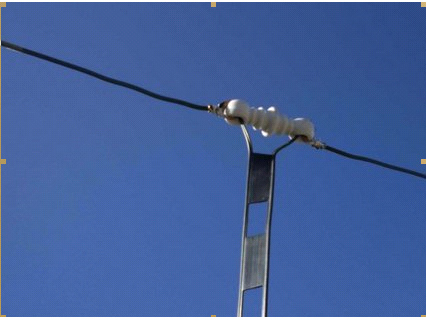
CENTER FED DOUBLET
1: Put up the longest, highest, flattest center fed wire you can fit in your yard, nothing wrong with the ends hanging down near non conductive end supports to add additional length. This antenna needs to be fed with open feed ladderline and will require a tuner to match efficiently to your 50 ohm radio. If you can get at least 75% of the length of your lowest band wavelength up in the air, this antenna will make your day on a lot of frequencies. My first choice for a new ham who wants to explore a bunch of bands.
FAN DIPOLE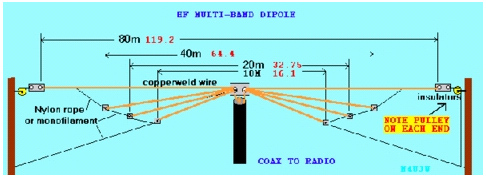
For shape reference only!
This kind of antenna allows the use of direct match to 50 ohm coax and should not need a tuner and will allow operation on mutibands with a little sweat equity on the construction side. Like I said in preamble, read up on this one, might fit your yard and your radio needs.
Not going to spend much more time on multi band antennas because once you have narrowed your focus as a newer ham you’re going to want to be louder than the guys using them, so next, a little time will be devoted to how to double your power out and increase that skip distance thing you memorized on your test!
Oh yeah; I GUARANTEE that either of the above antennas will work as well as or better than anything sold commercially for 10 times the price!
AND; I am aware it is a short list, counting on my antenna gurus reading this to jump in and expand!
But before someone else points out the obvious , let it be known that almost any piece of wire will get you on the air and be heard somewhere, but with a little homework you will enjoy designing something to fit in your backyard that will expand your horizons. During WW2 a little toy called a Slinky, yeah that thing, was used to successfully communicate on the battlefield! And hula hoops became super magnetic loops able to work the world at will, just kidding about that one.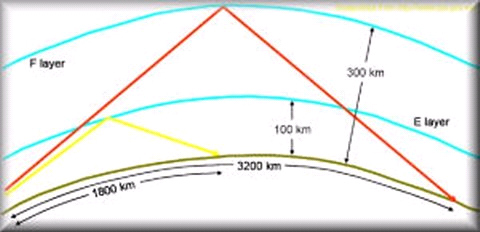
SO YOU WANT TO BE LOUD WAY OUT THERE?
Well that’s going to take a little work if you are willing to play with some wire.
On the upper bands pretty much everyone has a commercial, expensive beam on some sort, on a tower, not to worry, the same can be done at nominal cost with wire. On 40 and below a wire gain antenna is the way to go and not hard to do. And once you get a little more into phased reversible wire arrays you will be truly competitive with most of the tower/ commercial store bought beam guys on ANY band.
1: YE GOOD OLD DIPOLE!
The most efficient, easy to build mono band antenna out there. Unless you are getting creamed in some contest with the big guns firing up their $20,000 stations, you will be heard, HOW?; because by hook or crook you figured out a way to get that sucker up in the air at around ½ WL on the band of your choice! If DX is your new found interest then broadside it to the NE/SW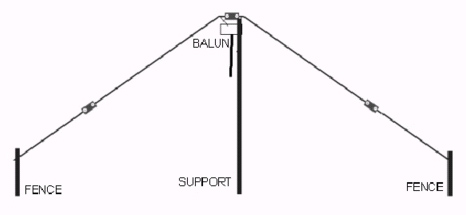
If tight for room or lack of supports an inverted vee up as high as possible will give good results also.
Build your own and you will be amazed on any band with a dipole, especially with the emerging sunspots. The secret to DX is the lowering of your take off angle into the ionosphere and getting that first skip into the, direction/ area you’re chasing, a good high dipole can do it, other designs do it better however.
2: WIRE GAIN ANTENNAS:
It is beyond the scope of this article to explain the intricacies of multi element beam antennas like the one way up there on your neighbor’s tower.
Wire beams are relatively simple to build and extremely cheap! Commercial aluminum beams for any band are based on the property of the dipole.
By adding some correct length and spaced wires in front of, or behind, or both, of a dipole you have now focused the antenna in a narrower direction, another way to define gain.
Think of a flashlight as opposed to a candle and you will get the jist of focused energy in a specific direction.
Simple Two Element Wire Beam: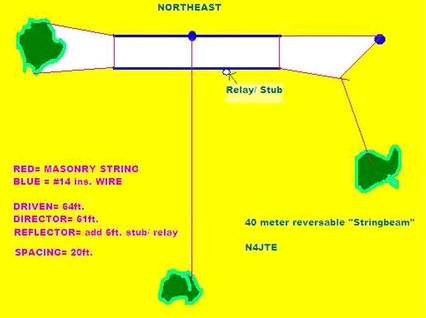
For shape reference only.
The addition of one wire 5% longer behind a dipole in the same plain will give you 3dbd of gain, in other words double your ERP; effective radiated power.
So that new 400 watt amp you saved up for will now have 800 watts going into the ionosphere. Oh yeah the extra power out works on receive also, adding an additional S unit and better signal to noise ratio for your hearing pleasure! You are focusing your transmitted signal in a smaller slice of the compass, helping diminish annoying signals off the side and the back.
This concept is applicable for every band from 2 meters to 160 meters; the spacing and between the two elements is subject to many variables and worth studying as is the possible shapes, quads, yagi, quagi etc.
The usual spacing between the wires for most gain is around .15WL.
If you have successfully built a dipole and remember the formula of 468/freq to achieve your ½ wl wire you are well on your way to using a little high school algebra to build your first beam antenna.
This process of free gain will open up an incredible arena of potential projects that will only be limited by your imagination and your commitment to studying the immutable laws of physics often contrary to a good portion of the advertisements we are all bombarded with everywhere.
Another worthy wire design is called a MOXON antenna with folded in elements that will fit where some wire beams will not. The moxon is a fun antenna and worth some serious study if you are plagued by loud stations behind you as it has very good front to back, meaning you will have an easier time hearing the station you are looking at.
Single Wire Gain Antennas:
About the only true single wire antenna that has 3db gain over a dipole is an EDZ, extended double zepp. These can be really long but if you have the room and tall enough supports this antenna will give you the same gain as a two element beam in two opposite directions. Mine has been up for years and has proven itself as the best narrow beam width single wire I have tried. Collinear antennas are a little shorter but have less gain so I stick with the EDZ.
Point being, as a new amateur either one might fit your needs so it’s worth the homework.
Getting Up In The Air:
The higher the band the smaller the antenna, nice little piece of physical law. Consider a 2 meter or a 10 meter wire beam built on the principals described above. Small enough to build and hang from any available tree and leave a string hanging from one corner to change directions, remember you built a directional beam, primitive maybe but mucho times better than the stub on your 2 meter hand held.
NO TREES ? Try something like below: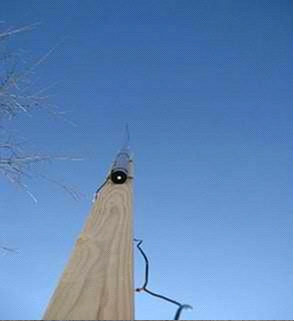
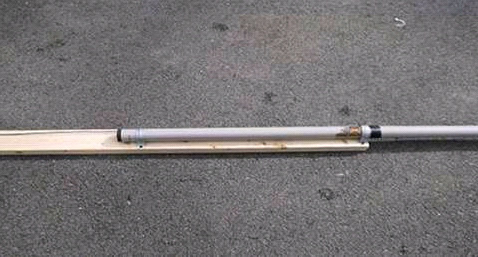 For an inverted vee or center of a dipole an easy to get 40 ft in the air pole for $50 is pictured. I use these things all the time in beam and vertical experiments They are 25ft extended and attached to a 2×4 and then to post holed 4×4, no concrete or help needed to install alone. Check fiberglass flag poles or Spider poles.
For an inverted vee or center of a dipole an easy to get 40 ft in the air pole for $50 is pictured. I use these things all the time in beam and vertical experiments They are 25ft extended and attached to a 2×4 and then to post holed 4×4, no concrete or help needed to install alone. Check fiberglass flag poles or Spider poles.
SUMMARY:
I suggest the best thing for a newly licensed ham to do is to get on the air and start chatting with people. You can ask them what antenna they are using and make your own deductions. Join a WAS net, like CCN or OMISS and see what you like or dislike about your present antenna. Determine if you have a favorite band that fits your interest and maybe upgrade to a mono band wire beam.
This article is a very cursory look at starter antennas and methods that will work great without killing your checkbook. Once you start down the road of designing and building your own antennas you will be addicted to this very important facet of our hobby and who knows, maybe you will writing a better article in the near future!
Tnx for reading,
N4JTE
Back to top^







